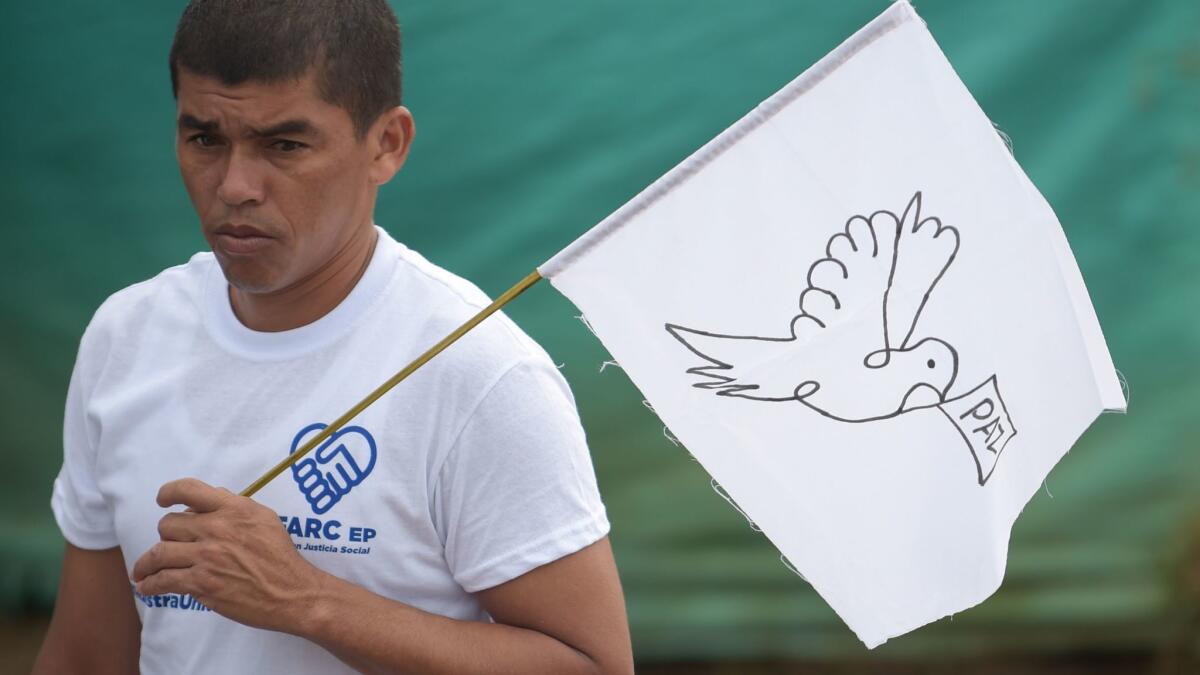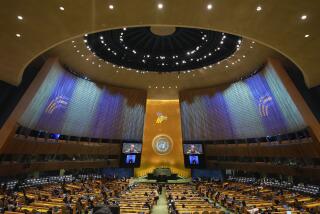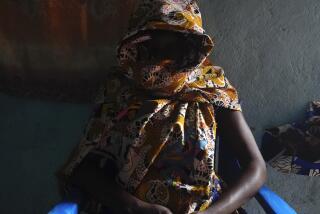Half a century of conflict in Colombia comes to close as FARC rebels disarm
- Share via
Reporting from BOGOTA, Colombia — In a ceremony that once seemed unimaginable, the Revolutionary Armed Forces of Colombia, or FARC, finished disarming on Tuesday as part of last year’s historic peace deal. With that, it officially morphed from an insurgent group that wrought violent havoc for more than half a century to a political entity aiming to attain power through the ballot.
President Juan Manuel Santos and FARC commander Rodrigo Londono, alias Timochenko, led the nationally televised ceremony in Mesetas, a rural town about 90 miles south of Bogota, the capital. About 2,000 ex-rebels, local officials and members of civil society groups and the media attended the ceremony.
Santos, who received the Nobel Peace Prize last year for pushing the peace deal amid widespread opposition among Colombians, told the gathering that the FARC has “exchanged arms for words.” Rebels were shown handing over weapons that United Nations officials then placed in white freight containers for storage and later destruction.
“Peace is irreversible,” Santos said. “Now we are just one people, just one nation. Long live peace.”
In addition to turning over the last of 7,132 weapons to the United Nations, the Marxist-Leninist FARC, which had been at war with the government since 1964, also gave the U.N. coordinates for 900 weapons caches spread around the country.
Now we are just one people, just one nation. Long live peace.
— Juan Manuel Santos, Colombian president
The ceremony was filled with images reflecting the FARC’s transition. Santos and Londono shook hands next to what appeared to be a golden assault rifle, but with a barrel that became the head of a shovel. A singer performed a song playing an instrument that appeared to be half gun, half guitar.
Although violence has decreased, Colombia is not yet tranquil. An estimated 250 FARC fighters have refused to disarm and remain at war with the government, said Bruce M. Bagley, a professor of international studies at the University of Miami. Another insurgent group, the 1,000-member National Liberation Army, or ELN, has resisted the government’s calls to negotiate and continues to kidnap and extort and to bomb oil pipelines.
Criminal drug trafficking groups, notably the so-called Urabenos gang, have rushed to fill the power vacuum in many rural areas once controlled by the FARC, Bagley said.
At Tuesday’s ceremony, rebels dressed in T-shirts instead of combat fatigues received plastic ID cards qualifying them for post-conflict aid programs. Mesetas is one of 26 “transition villages” scattered across rural Colombia where about 7,000 rebels were relocated from jungle and mountain hide-outs for the demobilization process.
After Aug. 1, the 26 locations will become “training and reincorporation spaces,” where rebels will receive education and counseling designed to ease their reentry into Colombian society.
“Today doesn’t end the existence of the FARC. It merely replaces the armed struggle with exclusively legal means,” rebel leader Londono told the gathering, adding that the FARC’s goal in peacetime will remain the same as it was during half a century of warfare, to attain power.
With their party guaranteed at least 10 seats in Congress for two terms starting 2018, FARC leaders will hold a convention in August to develop a political strategy, which could include forming alliances with existing parties or striking out on their own, leaders told reporters this week. Adam Isacson, a Colombia expert with the Washington Office on Latin America think tank, said they may use a nascent left-wing party called Marcha Patriotica as their electoral vehicle.

Colombia remains sharply divided over implementation of the peace accord, which the FARC signed last year. Opposing the accord as too generous to the rebels, a narrow majority of voters rejected it in an October plebiscite. Santos then sidestepped the voters and received congressional approval in November.
Skeptics worry that former rebels won’t forswear criminal activities, including extortion and drug trafficking, while some backers of the peace deal doubt the government can keep its promise to funnel billions in agricultural aid and provide adequate protection to demilitarized rebels.
“It’s going to be fascinating to watch how the FARC transforms itself into a political force because it’s so rural and so unpopular,” Isacson said.
Colombians’ distrust of the FARC runs deep, and with Santos’ voter approval ratings at only 30%, he has been unable to generate broad popular support for the peace deal. Former President Alvaro Uribe, now a powerful senator and leading critic, has said he would urge a repeal of some of the accord’s provisions if his party’s candidate wins the presidency in 2018.
For his part, Londono said his rebels are concerned about the government’s ability to protect the FARC’s rank and file from attacks by right-wing paramilitary groups, a reference to how hundreds of members of the leftist Patriotic Union party were assassinated in the late 1980s because of its links to the FARC. He noted that several leftist social activists have been slain in recent months.
“Colombia will not tolerate another fraud,” Londono said.
Lisa Haugaard, executive director of the Washington-based Latin America Working Group, a human rights advocacy group, said the FARC disarming should be seen as a “day of joy” and as a step toward a “more inclusive and peaceful Colombia.”
“But everyone must play their part to have real peace, or this chance will be lost for another generation,” Haugaard said. “The Colombian government must implement the accords, including its commitments to reintegrate the guerrillas and bring the civilian state into neglected, war-torn areas.”
Kraul is a special correspondent.
ALSO
Cyberattack using data-scrambling software causes disruptions in Europe
How dinner with a lesbian couple changed Angela Merkel’s position on same-sex marriage
Venezuela tragedy: 15 images capture a nation’s sorrow and turmoil
More to Read
Sign up for Essential California
The most important California stories and recommendations in your inbox every morning.
You may occasionally receive promotional content from the Los Angeles Times.










